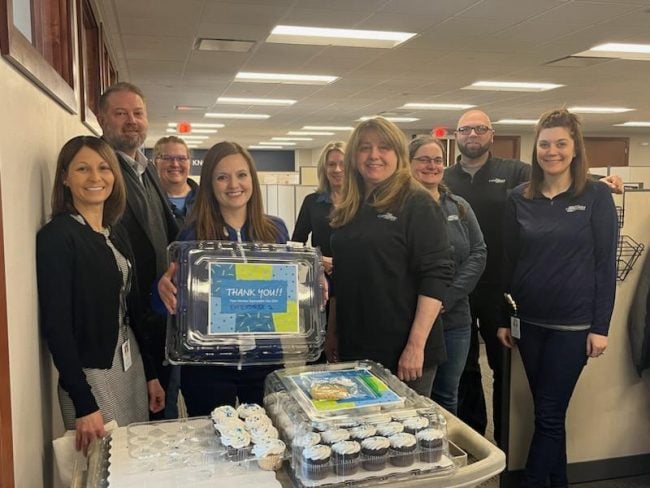 In March 2014 whenFMSI introduced its 2014 Retail Branch Lobby Study, a comprehensive study of265,000 sales and service interactions by financial institutionsacross North America, several key findings emerged. A closeranalysis of these metrics shows that despite making progress withmore effective selling, many financial institutions have a long wayto go before they will enjoy major productivity and customerservice gains in their lobbies.
In March 2014 whenFMSI introduced its 2014 Retail Branch Lobby Study, a comprehensive study of265,000 sales and service interactions by financial institutionsacross North America, several key findings emerged. A closeranalysis of these metrics shows that despite making progress withmore effective selling, many financial institutions have a long wayto go before they will enjoy major productivity and customerservice gains in their lobbies.
Lobby wait times are up.
|Despite the focus many financial institutions place on service,the study found that customer wait times continued to inch up, by5% since the last study conducted two years earlier. (Branch lobbywait times, overall, crept up from 4:46 minutes to 5:08 minutes.)Even more important, perhaps, was the discrepancy between top andbottom performers. The top 10 institutions had wait times thataveraged 3:46 minutes (30 seconds longer than in 2011). The bottom10 institutions averaged 6:59 minutes – nearly double that of thetop performers' average.
|An increase in wait times is understandable, given that manybranches have cut staff to reduce operating expenses. However,understandable doesn't mean forgivable. Customer service issubjective, and if a branch is percolating with business, customerswill generally accept a longer wait, especially if it results in agreat service experience at the end. If the branch lobby isrelatively empty and staff response is slow, customers are not asforgiving.
|Assistance time explodes for bottombranches.
|Customer assistance times showed a similar disparity, withaverage assistance times for top performers actually droppingslightly, from 17:58 to 17:38 minutes. For the bottom 10, averageassistance times rose from 24:45 to 26:24 minutes, a whopping 50%longer than the average for the top 10 performers. Looking at thesenumbers, one can surmise that the excessive wait times at thelow-performing branches are being driven, at least in part, byexcessive assistance times.
|Product-to-service ratios still off.
|The final key metric from the study was that even the bestperforming financial institutions are not making the optimal60%/40% product-to-service ratio. The best performers achievedapproximately a 50%/50% product to service split, but the 10 bottomperformers averaged 26% product interactions versus 74% serviceinteractions. Given that these bottom performers are spending farmore time with customers, as well, this metric is verydisappointing. Overly long assistance sessions cannot be justifiedby these outcomes.
|Analyzing the lobby study: What improvements do thesemetrics suggest?
|The 2014 Retail Branch Lobby Study provides some interestinginsights that financial institutions can apply to their ownsituations. Even without a lobby tracking solution, financialinstitutions can record customer wait times and assistance times ona limited basis. If the results are as poor as those of the bottomgroup of financial institutions, branch management must takeaction.
|Excessive wait times are often caused by a lack of informationavailable to branch personnel. If a manager has a means of knowingwhen waits are excessive (whether propelled by technology-basedalerts or lobby personnel visually inspecting sign-in sheets), heor she can take action by moving a universal associate from anotherarea, perhaps, or stepping in directly to help customers.“Pre-screening” customers through personal interaction in thewaiting line, or the use of a tablet-based sign-in solution, canreduce wait times or make the perceived wait shorter.
|Regarding excessive assistance times, these can result from bothpositive and negative interactions and it is crucial for branchesto discern which is causing the issue. If assistance sessionsresult in higher sales figures, management might have justificationfor staff increases. If high assistance times are driven by “oversocializing” or inefficient, non-productive procedures, managementneeds to address its personnel (through coaching), its processes orboth.
|Finally, to improve the product-to-service ratio, better/moretraining in “needs-based” selling is often effective. Simply askingmembers the right questions and active listening can have aprofound impact in creating the right sales environment.
|What's happening in your lobby and how can you improve it?
|Although every financial institution and branch is unique,the statistics presented in this article are validated by anenormous body of evidence. We invite credit unions to use the studyas a benchmark for their own analyses and improvement efforts. Thefirst step, of course, is some type of lobby-data intelligencegathering and analysis. Without metrics, you can't initiate animprovement strategy. Once you have an idea where your lobbyplaces, in terms of performance, your credit union will be in aposition to make positive improvements.
|Meredith Deen is chief operating officer of FMSI. She can bereached at [email protected] or (877)887-3022.
Complete your profile to continue reading and get FREE access to CUTimes.com, part of your ALM digital membership.
Your access to unlimited CUTimes.com content isn’t changing.
Once you are an ALM digital member, you’ll receive:
- Critical CUTimes.com information including comprehensive product and service provider listings via the Marketplace Directory, CU Careers, resources from industry leaders, webcasts, and breaking news, analysis and more with our informative Newsletters.
- Exclusive discounts on ALM and CU Times events.
- Access to other award-winning ALM websites including Law.com and GlobeSt.com.
Already have an account? Sign In
© 2024 ALM Global, LLC, All Rights Reserved. Request academic re-use from www.copyright.com. All other uses, submit a request to [email protected]. For more information visit Asset & Logo Licensing.









